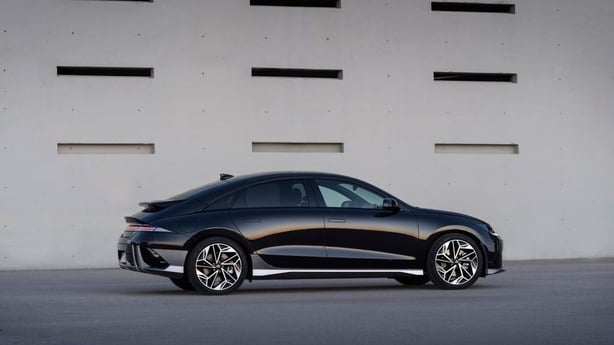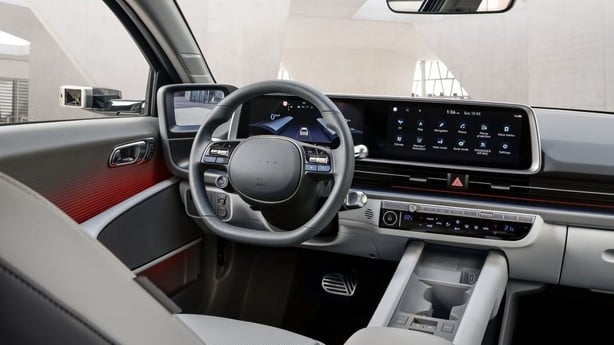If you want to understand the logic behind the styling - and indeed the appeal - of the Ioniq 6 you'll have to go back a long way, as the car’s designers obviously did.
Back to the 1930’s, in fact, when engineers and designers began experimenting with what were known as streamliner concepts - resulting in vehicles that would be sleeker than everything before them, travel with the least wind resistance and achieve higher speeds.
The Germans designed the Schienenzeppelin, a propellor-driven train that achieved about 230 km/hour and a former GM designer, Phil Wright, created the revolutionary Silver Arrow that was a pioneering exercise in aerodynamics. While it was never a commercial success (neither was the Schienenzeppelin, by the way), the Silver Arrow quickly began to influence other designers in their quest to "cheat the wind" - reducing drag with slippery designs that increased speed.

Hyundai uses the term "electrified streamliner" to describe the Inoniq 6. It’s certainly justified when you look at the way the rear of the car simply disappears into a dramatic slope, creating a distinct contrast with the front. In terms of the drag factor, it’s measured at 0.21. For comparison purposes, the drag factor of the boxier Ioniq 5 is 0.29.
During my test drive everyone seemed to have an opinion on the car, even if those opinions were often sharply divided.
Broadly speaking, some men seemed a little undecided while others instantly took to it. Women seemed to appreciate the dramatic lines much more quickly and some remarked on it as being different and refreshingly non-SUV in its profile. Some particularly remarked on the retro looks. Well, that’s exactly what Hyundai would have wanted - it already has the Ioniq 5 to tick the more conventional boxes.
For my own part, I really liked the car - not just for its unconventionality but also for its levels of refinement, comfort and quietness. Most of all though, I loved its efficiency. The car weighs about two tonnes so the battery has to work hard to push that weight. However, I still managed to regularly get energy consumption returns of about 14kWh in mixed driving conditions. That is very efficient indeed for a car of its size - other similar car would be inclining more towards 18kWh per 100 kilometres in the same conditions.
That type of consumption makes for comfortable ranges. While the official WLTP test has returned figures for the Ioniq 6 of 429 kilometres for the smaller 53 kWh battery and 614 km for the 77 kWh battery version, which I drove, I managed to get about 440 km from it (it can be hard to measure range specifically as I, for one, am not going to risk a dead battery by running it to the limit).
The 0 to 80 per cent charge time on a fast charger takes about half an hour. Thank goodness for the private Ionity network as a fallback for long-distance drivers, who may have to pay a charging premium but can avoid the while knuckle moments one can often experience with the ESB network, which is only slowly beginning to improve.
440 kilometres is a very comfortable range for the car and the predictive battery charge indicator reassured me considerably with its accuracy. Linked to the sat nav. map, it told me fairly accurately when I’d need to get boosted again.
That sweeping roofline and a shoulder line that extends deep to the rear of the car does have some consequences. Rear head space is predictably low for very tall passengers and the same can be true for a tall driver. Otherwise, however, the cabin is generously spacious, bright and very comfortable, thanks in the main to very well constructed and finished seating.
Compared to a competitor like the Polestar 2, the ride was a little on the soft side but that wasn’t something that bothered me. In fact, it made the car feel slightly more luxurious as it wafted over rougher surfaces.

The dominant interior feature is the two 12.3" screens that control functions and infotainment. The graphics are clear and easy to read and, thankfully, Hyundai has retained old-fashioned buttons for quick key functionality when required. Other manufacturers should take note because this is both a clever and a practical compromise in software dominated cars.
The boot is a bit limited, at just over 400 litres but it’s fairly practical. There is a tiny extra bit of storage space under the "bonnet" for charging cables and the like.
The 6 has a full five star rating from EuroNCAP for safety and there’s no shortage of electronic and safety features. There are clever innovations too. There’s a three-pin plug in the back, there are 2 USB connections in the front and the rear and digital wing mirrors are a brilliant innovation.
The smaller 58 kWh battery version comes in at €48,295 and the bigger 77.4 kWh battery version is priced at €54,315. Those prices include public grants.
So, the Ioniq 6 isn’t cheap. It is, however, a big car that offers a creative alternative to SUV and crossover styling.
You’re also likely to see many of the car’s best features in smaller and less expensive Hyundai cars in the not too distant future.


